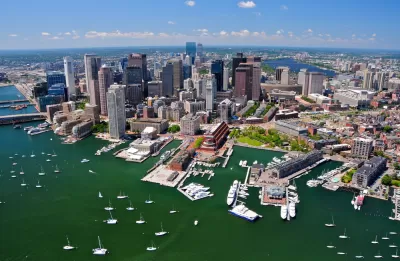As it vies to host the 2024 Summer Games, Boston's plan envisions two new permanent neighborhoods built with a mix of public and private investment. The final decision will take place in September.

The Olympics can be a mixed blessing for host cities. The influx of money and attention is temporary by definition, and needs to be integrated into long-term development plans. To that end, Boston intends to position its Olympics "less as the ultimate goal of the planning effort and more of a waypoint along a sweeping 18-year economic development project."
"With the fate of Boston's Olympic bid in the balance, Boston 2024 sketched out plans to use generous city tax breaks to prompt development of 8,000 units of housing among 12 million square feet of new, permanent development." The plan takes loosely after Hudson Yards, a large-scale private development currently under construction in New York City.
"Essential to the plan is $4 billion in private sector investment, undertaken in conjunction with $775 million in taxpayer financed transportation projects, which the committee maintains are needed with or without the Olympics." Seeking to quell fears about bold or risky investment, Boston 2024 has already earmarked over $100 million to insure its putative Games.
"With polls suggesting public support for hosting the Games is below 50 percent, the committee's future rests on how well its 2.0 plan stands up to public and expert scrutiny. The US Olympic Committee faces a September deadline to formally name a city for the international contest for the 2024 Games. The Boston bid is unlikely to go forward if the new plan falls flat."
FULL STORY: New Olympics plan would give rise to 2 neighborhoods

Alabama: Trump Terminates Settlements for Black Communities Harmed By Raw Sewage
Trump deemed the landmark civil rights agreement “illegal DEI and environmental justice policy.”

Planetizen Federal Action Tracker
A weekly monitor of how Trump’s orders and actions are impacting planners and planning in America.

The 120 Year Old Tiny Home Villages That Sheltered San Francisco’s Earthquake Refugees
More than a century ago, San Francisco mobilized to house thousands of residents displaced by the 1906 earthquake. Could their strategy offer a model for the present?

In Both Crashes and Crime, Public Transportation is Far Safer than Driving
Contrary to popular assumptions, public transportation has far lower crash and crime rates than automobile travel. For safer communities, improve and encourage transit travel.

Report: Zoning Reforms Should Complement Nashville’s Ambitious Transit Plan
Without reform, restrictive zoning codes will limit the impact of the city’s planned transit expansion and could exclude some of the residents who depend on transit the most.

Judge Orders Release of Frozen IRA, IIJA Funding
The decision is a victory for environmental groups who charged that freezing funds for critical infrastructure and disaster response programs caused “real and irreparable harm” to communities.
Urban Design for Planners 1: Software Tools
This six-course series explores essential urban design concepts using open source software and equips planners with the tools they need to participate fully in the urban design process.
Planning for Universal Design
Learn the tools for implementing Universal Design in planning regulations.
Clanton & Associates, Inc.
Jessamine County Fiscal Court
Institute for Housing and Urban Development Studies (IHS)
City of Grandview
Harvard GSD Executive Education
Toledo-Lucas County Plan Commissions
Salt Lake City
NYU Wagner Graduate School of Public Service



























